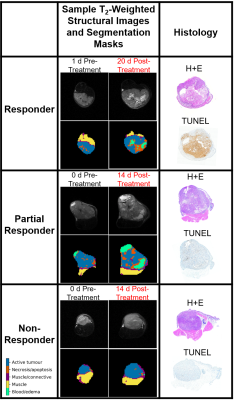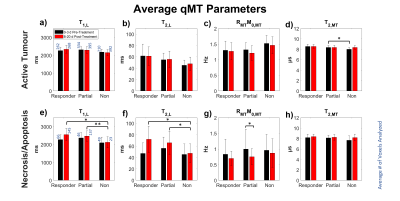Leedan Murray1, Wilfred W. Lam1, and Greg J. Stanisz1,2
1Physical Sciences, Sunnybrook Research Institute, Toronto, ON, Canada, 2University of Toronto, Toronto, ON, Canada
1Physical Sciences, Sunnybrook Research Institute, Toronto, ON, Canada, 2University of Toronto, Toronto, ON, Canada
MT and CEST characteristics of DU145 prostate tumour
xenografts with known responses to radiation were investigated. Significant changes between responses
were mostly observed in the necrotic/apoptotic regions of the tumour and were
most evident in the qMT parameters.

Figure 1: Representative
segmentation masks, T2-weighted images and histology (H+E and TUNEL
stains) for each category of response to radiation treatment (responder, partial
responder, non-responder).

Figure 4: Average
estimated qMT parameters by treatment response of (a-d) active and (e-h)
necrotic/apoptotic regions. Free parameters were: T1 and T2
of the water pool (T1,L and T2,L respectively), the exchange rate of
magnetization from the MT pool to the water pool (RMT), original
magnetization of the MT pool relative to the water pool (M0,MT), and
T2 of the MT pool (T2,MT). *p < 0.05. **p < 0.01.
